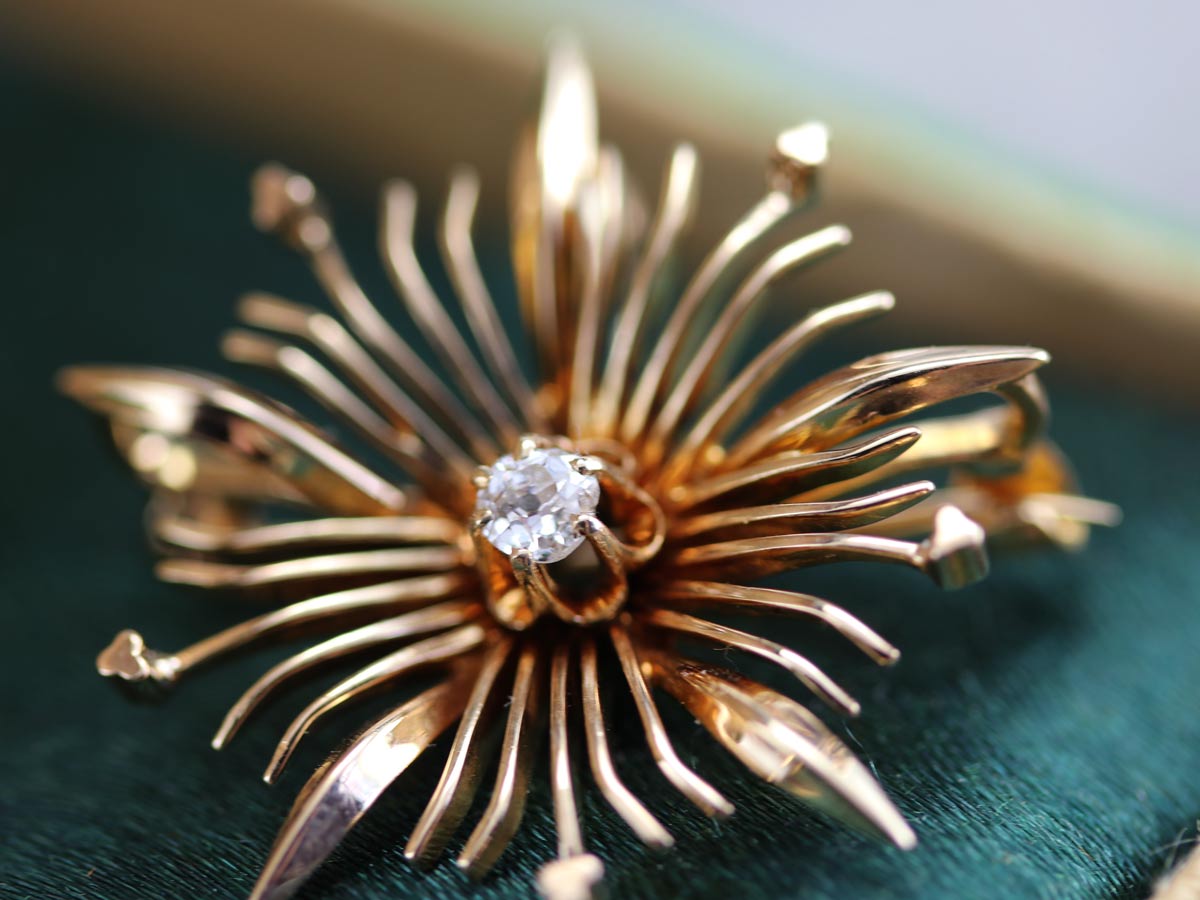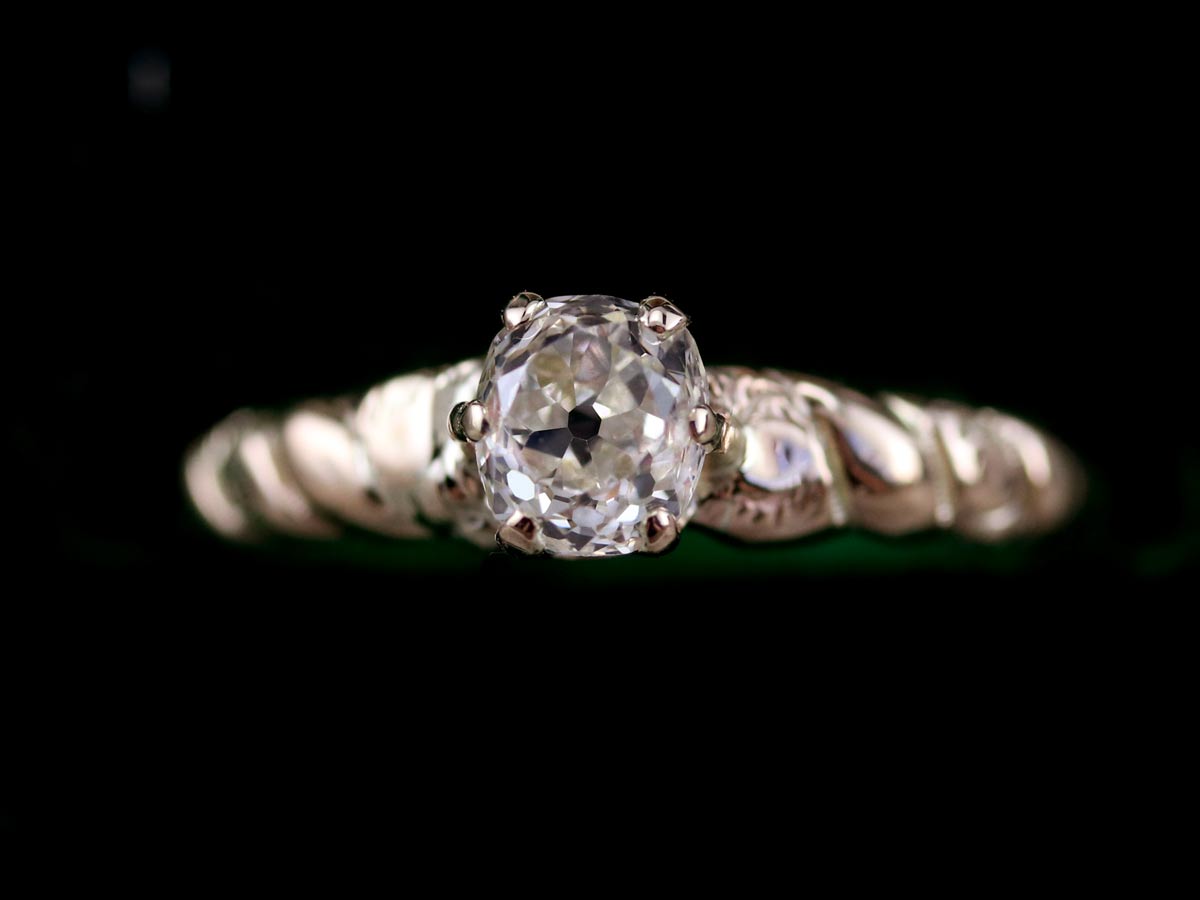Your Cart is Empty

If you've ever shopped for antique diamond jewelry, you've likely come across the term "Old Mine Cut". Old Mine Cut diamonds have a unique beauty entirely on their own. They don't have the mathematical symmetry of modern brilliant cuts, nor the novelty of colored fancies, but what they do have, they have in abundance: romance, mystique, history, and sparkle. Learn a little more about Old Mine Cut diamonds, and you'll be sure to fall in love with them.
Old Mine Cut diamonds date anywhere from the early 18th Century to the late 19th Century. It is believed that the term came into use around the 1860's, when the discovery of diamonds in South Africa and subsequent technological improvements in diamond cutting necessitated the distinction between "new" and "old" diamonds. "Old Mine" refers to the previously used diamond mines of Brazil or India. Today, we use the term to describe antique diamonds with specific characteristics.

An Old Mine Cut diamond has certain general characteristics that distinguish it from other diamond cuts. To understand the differences between cuts, it is helpful to know some basic diamond terminology.
Table - the flat top of the diamond; these will vary in size depending on the era from which the gem was cut
Facet - the individual cut plains around the table and underneath the diamond; the size, shape, angle, and amount of facets determine how the diamond sparkles and are crucial to the overall appearance
Culet - the point on the underside of the diamond at which the facets converge towards the center; the culet may range from a sharp point to flat
Girdle - the middle portion of the diamond separating the crown (top) from the pavilion (lower part); this determines the shape of the gem when seen from above.
The characteristics of an Old Mine Cut diamond are easier to understand by looking at these four parts, which are visible by viewing the gem through a simple loop magnifier. Look at the diamond from the top. The table of an Old Mine Cut diamond is usually smaller than that of a modern brilliant cut. You will also notice that the shape of the diamond is not perfectly round, usually square or slightly irregular. This is referred to as a cushion cut, when the gem has slightly rounded corners and the sides bow out (rather like a cushion would). Though an Old Mine Cut has the same amount of facets as a modern brilliant cut (58), the shape and proportions vary greatly (see diagram below).
Another distinct characteristic of an antique cut diamond is a flat culet. Look through the top of an Old Mine Cut diamond and you will see what looks like a small hole. This is not a hole, but actually the flat culet. In modern brilliant cuts, the culet comes to a sharp point and is perfectly centered. In antique cuts, the culet may be visibly off center. As technology developed, the culet became more and more precisely centered.
An Old Mine Cut diamond set into an Art Deco reproduction filigree ring (the Marcy setting by Elizabeth Henry). The off-center flat culet is clearly visible.
Old Mine Cut diamonds can vary a lot in shape, which is due in part to the lack of universal standards and cruder methods for diamond cutting, but also due to the fact that older diamond cutting mimicked the shape of the natural diamond crystal. If you come across a diamond that has all the characteristics of an Old Mine Cut, but is round in shape, you may be looking at an Old European Cut diamond. Euro Cuts have a flat culet (but they are more centered) and a small table. The crown also tends to be higher – a characteristic that looks dramatic when compared to a modern diamond.
Both Old Mine and European Cut diamonds were used in the 19th Century, however it is the European Cut that was the precursor to the modern brilliant cut we use today. The European Cut diamonds that you are likely to come across in commercially available antique jewelry were likely cut in the latter part of the 19th Century or early 20th Century. To add even more confusion, there are diamond cuts that fall in between these diamond evolutions called transitional cuts, when an Old Mine is not quite a Euro, or when a Euro is not quite a modern brilliant.

This diagram shows the difference in facet patterning between Old Mine and European cuts. The European Cut more closely resembles the brilliant cuts of today.
We love Old Mine Cut diamonds for the same reason we love antique jewelry. The craft was not about mass production, where the goal is to eliminate variance. It was in individual approach that resulted in one-of-a-kind works of art. When you look at an Old Mine Cut diamond, you think about its history, about the physical hand of the gem cutter, in a way that you don’t when you look at a modern brilliant cut. If you've ever seen an Old Mine Cut diamond, you know it sparkles in a way that modern cuts can't compare to. These old diamonds were cut by lamp light, and thus they sparkle beautifully in many different light conditions. Is there anything more romantic than a diamond glittering in the candlelight? When shopping for Old Mine Cut diamonds, try looking at them in both artificial and natural light if you can – you'll get a whole new perspective.
From the history, to the beauty, there is a lot to love about antique diamonds. Though we attempted to describe them here, Old Mine Cut diamonds are really something you should see in person to fully appreciate. Stop into any of our store locations to see a side by side comparison of diamond cuts, or bring in a diamond of your own if you are interested in learning more about it. We also offer appraisal services if you are looking for a more in depth analysis.
Click here to shop our online collection of Old Mine Cut and European Cut diamond jewelry.


